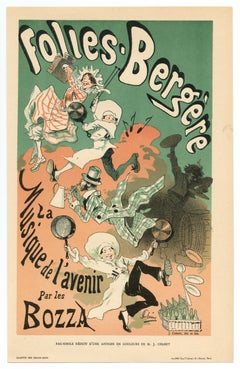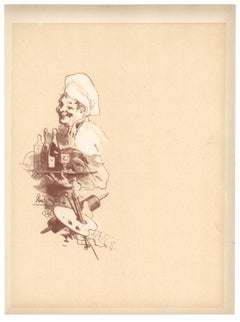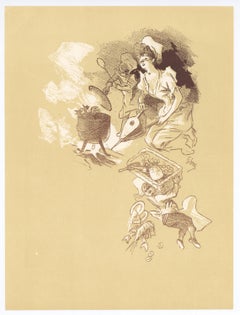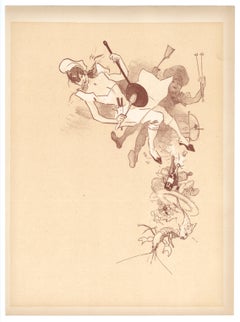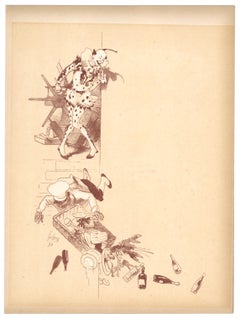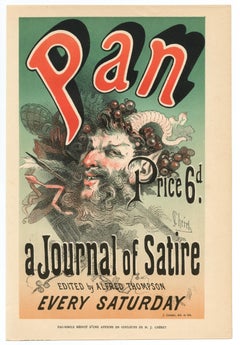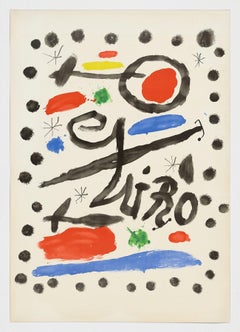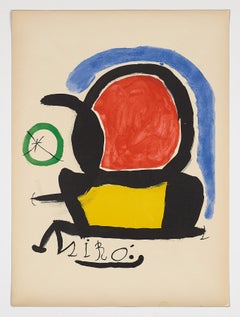(after) Jules Cheret Art
to
7
Overall Width
to
Overall Height
to
6
1
1
1
7
5
3
2
2
2
1
1
1
1
1
1
1
7
7
8,230
2,806
1,652
1,317
7
Artist: (after) Jules Cheret
"Folies-Bergere" lithograph
By (after) Jules Cheret
Located in Henderson, NV
Medium: lithograph (after the poster). This lithograph (in reduced size) was published in Paris in 1884 by Gazette des Beaux Arts. Size: 10 1/2 x 6 3/4 inches (268 x 170 mm). Signed ...
Category
1880s (after) Jules Cheret Art
Materials
Lithograph
lithograph
By (after) Jules Cheret
Located in Henderson, NV
Medium: lithograph (after the original menu illustration). Printed in 1897 on smooth wove paper and published in Paris by Librairie Nilsson. Sheet size: 12 1/4 x 9 inches (310 x 230 ...
Category
1890s (after) Jules Cheret Art
Materials
Lithograph
"La poule au pot" lithograph
By (after) Jules Cheret
Located in Henderson, NV
Medium: lithograph (after Cheret). Executed by Jules Cheret in 1894 for a menu, this edition was printed on light brown paper in 1932 for Arts et Metiers Graphiques. Size: 12 x 9 1/4...
Category
1930s (after) Jules Cheret Art
Materials
Lithograph
lithograph
By (after) Jules Cheret
Located in Henderson, NV
Medium: lithograph (after the original menu illustration). Printed in 1897 on smooth wove paper and published in Paris by Librairie Nilsson. Sheet size: 12 1/4 x 9 inches (310 x 230 ...
Category
1890s (after) Jules Cheret Art
Materials
Lithograph
lithograph
By (after) Jules Cheret
Located in Henderson, NV
Medium: lithograph (after the original menu illustration). Printed in 1897 on smooth wove paper and published in Paris by Librairie Nilsson. Sheet size: 12 1/4 x 9 inches (310 x 230 ...
Category
1890s (after) Jules Cheret Art
Materials
Lithograph
"Pan" lithograph
By (after) Jules Cheret
Located in Henderson, NV
Medium: lithograph (after the poster). This lithograph (in reduced size) was published in Paris in 1884 by Gazette des Beaux Arts. Size: 10 5/8 x 7 inches (265 x 180 mm). Signed in t...
Category
1880s (after) Jules Cheret Art
Materials
Lithograph
Grand Theatre de l’Exposition, from Les Maîtres de l'Affiche
By (after) Jules Cheret
Located in New York, NY
This lithograph in colors with raised chop mark was printed by Imprimerie Chaix in Les Maîtres de l'Affiche, 1899, on fine woven, heavy stock paper. Measures 15 ¾ x 11 3/8 (40 x 29 c...
Category
19th Century Modern (after) Jules Cheret Art
Materials
Lithograph
Related Items
Original Unused 1964 Avant La Lettre Lithograph Gaspar Room Metras Belarte
By Joan Miró
Located in Miami, FL
Joan Miró (Spain, 1893-1983)
'Sala Gaspar, Metras and Belarte Gallery (avant la lettre)', 1964
Lithograph on Paper (Cahiers d'Art magazine Nº4-5)
Original lithograph without signing ...
Category
1960s Abstract (after) Jules Cheret Art
Materials
Lithograph
$580
H 39.4 in W 27.6 in
Joan Miró 1970 El Tapís de Tarragona (edition Avant La Lettre) original litho
By Joan Miró
Located in Miami, FL
The work was conceived as a poster for the exhibition "Miró el tapís de Tarragona".
Technical details of the work
Category: Engravings and Prints Graphic Work
Date: 1970
Technique: ...
Category
1970s Abstract (after) Jules Cheret Art
Materials
Lithograph
Eduardo Chillida Spanish Artist Original Unused Lithograph Poster
By Eduardo Chillida
Located in Miami, FL
Eduardo Chillida (Spain, 1924-2002)
'5 Livres Gravés', 1974
Original poster from show
lithograph on paper
25.2 x 17 in. (64 x 43 cm.)
Unframed
Ref: CHI100-202
Eduardo Chillida
He be...
Category
1970s Expressionist (after) Jules Cheret Art
Materials
Lithograph
$350
H 25.19 in W 16.92 in
John Gould - Chestnut-bellied Tit from 'The Birds of Asia' C. 1850
By John Gould
Located in BRUCE, ACT
Chestnut-bellied Tit - John Gould lithograph with hand-coloured
size 54 cm X 37 cm
excellent Condition
FREE SHIPPING
This remarkable ornithology...
Category
Late 18th Century (after) Jules Cheret Art
Materials
Lithograph
$740
H 22.45 in W 13.39 in
Speckled Corn Kachina, Dan Namingha, lithograph, Hopi, kachina, blue, orange
By Dan Namingha
Located in Santa Fe, NM
Speckled Corn Kachina, Dan Namingha, lithograph, Hopi, kachina, blue, orange
hand pulled limited edition lithograph
signed and numbered by the artist
Glenn Green Galleries also pr...
Category
1970s Contemporary (after) Jules Cheret Art
Materials
Lithograph
"Changes with the wind" 1972 original signed engraving lithograph American artis
Located in Miami, FL
Robert Smith (United States, 1944)
'Changes with the wind', 1972
Engraving
21.7 x 29.6 in. (55 x 75 cm.)
Edition of 75
ID: SMI1158-003-075
Hand-signed by author
Category
1970s Contemporary (after) Jules Cheret Art
Materials
Lithograph, Engraving, Etching
Uncle of the Corn Dancers, Dan Namingha, Hopi, kachina, lithography edition
By Dan Namingha
Located in Santa Fe, NM
Uncle of the Corn Dancers, Hopi, kachina, lithography Dan Namingha
hand pulled limited edition lithograph
signed and numbered by the artists
Category
1970s Contemporary (after) Jules Cheret Art
Materials
Lithograph
Cristobal Toral Spanish Artist Original Still-life Hand Signed Lithograph Color
Located in Miami, FL
Cristobal Toral (Spain, 1940)
'Bodegón', ca. 1990-2000
lithograph on paper
21.3 x 17.8 in. (54 x 45 cm.)
Edition of 225
ID: TOR1167-001-225
Hand-signed...
Category
21st Century and Contemporary Contemporary (after) Jules Cheret Art
Materials
Lithograph
BLUE DOOR AT HANO, Hopi, Arizona abstract village green yellow black turquoise
By Dan Namingha
Located in Santa Fe, NM
hand pulled limited edition lithograph signed and numbered by the artist Our gallery also presents paintings, prints and sculpture by Southwestern luminary, DAN NAMINGHA. Our colle...
Category
1970s Contemporary (after) Jules Cheret Art
Materials
Lithograph
$1,600
H 28 in W 22.5 in
Mask Assemblage, limited edition lithograph, black and white, kachina imagery
By Dan Namingha
Located in Santa Fe, NM
unframed black and white lithograph by Dan Namingha
Kachina Katsina Katsinam faces
Category
1980s Contemporary (after) Jules Cheret Art
Materials
Lithograph
John Gould - Afghan Tit from 'The Birds of Asia' C. 1850
By John Gould
Located in BRUCE, ACT
Afghan Tit - John Gould lithograph with hand-coloured
size 54 cm X 37 cm
excellent Condition
FREE SHIPPING
This remarkable ornithology lithograph with hand-finished colour is from the esteemed John Gould’s Birds...
Category
Late 18th Century (after) Jules Cheret Art
Materials
Lithograph
Night Chanters, black and white limited edition lithograph Hopi Kachinas
By Dan Namingha
Located in Santa Fe, NM
lithograph 20" high x 15" wide
unframed signed and numbered...
Category
1980s Tribal (after) Jules Cheret Art
Materials
Lithograph
$1,600
H 20 in W 16 in
(after) Jules Cheret art for sale on 1stDibs.
Find a wide variety of authentic (after) Jules Cheret art available for sale on 1stDibs. You can also browse by medium to find art by (after) Jules Cheret in lithograph and more. Much of the original work by this artist or collective was created during the 19th century and is mostly associated with the modern style. Not every interior allows for large (after) Jules Cheret art, so small editions measuring 7 inches across are available. (after) Jules Cheret art prices can differ depending upon medium, time period and other attributes. On 1stDibs, the price for these items starts at $80 and tops out at $695, while the average work can sell for $100.
Questions About (after) Jules Cheret Art
- 1stDibs ExpertApril 5, 2022Jules Cheret contributed to poster history by changing how the art world viewed posters. In 1884, he showed his works in the first-ever gallery exhibition of posters, helping to elevate the art form. Find a variety of Jules Cheret art on 1stDibs.
